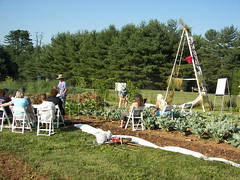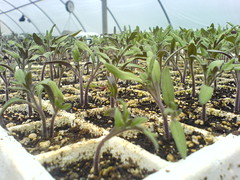Tuesday, May 12, 2009
Techniques and Tips for Your Garden
Are you ready to dig into your own soil and begin harvesting a bounty of fresh produce this summer? Join the Local Food Project for our Organic Garden Primer workshop on May 21 from 6-8 p.m. and gather essential information for success in your backyard garden. This fun evening event will provide helpful ideas from the LFP crew and local small farmers, plus the chance to explore the LFP garden and hoophouse, try out handtools, and network with other local food fans. Light fare and local refreshments are in included in the $20 workshop fee. To register, send an email to Brynn Slate at bslate@airlie.org. See you there!
Wednesday, May 6, 2009
We Want Candy…and 1st Edition and Leeks!
It’s onion planting time at the Local Food Project garden and we’re excited about getting this crop in the ground. We planted Candy, a delicious yellow onion we couldn’t get enough of last year, alongside Red Candy Apple, a new red variety from Dixondale Farms. In another section (five 3x33 foot beds), we’ll plant 1st Edition and Red Torpedo Tropea, then put in a section of leeks. We’re also experimenting with two different planting styles. The first is our regular four-row, one onion every six inches layout. The second has only two rows spaced wider apart and bunches of four onions every foot. The same number of onions go into each 33 foot bed so we’ll see how they do and compare the yields from each.
Monday, May 4, 2009
Lunchtime for Tomato Starts
At the end of March the Local Food Project crew started our summer tomato crop in flats. We sowed seeds for our favorite cherry tomato (Sun Gold), a strain of Roma selected especially for Virginia, a volunteer heirloom we saved seeds from last year, plus several purple/black tomatoes to compare which varieties we like best—Black from Tula, Cherokee Purple, Nyagous, and Purple Russian. Now (about four weeks later) we’re transferring the tiny seedlings to larger flats, giving them a fresh dose of nutrients and more space to spread their roots—a tasty lunch after breakfast in the smaller flats. Soon they’ll help themselves to dinner in the soil of our garden.
Subscribe to:
Posts (Atom)



